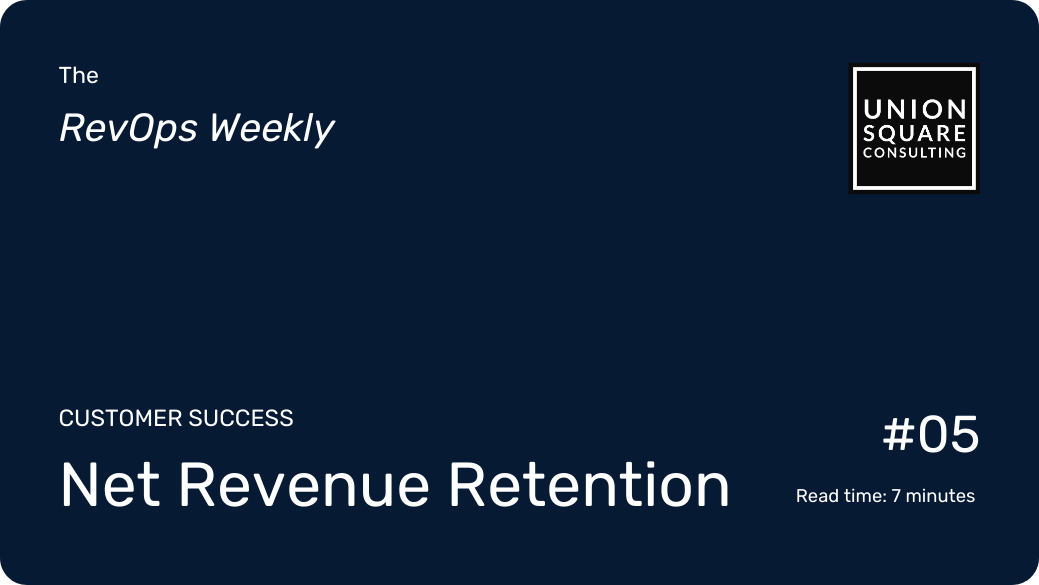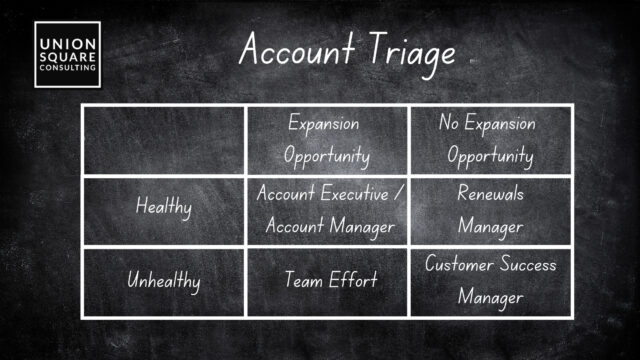
Net Revenue Retention
Read time: 7 minutesRaising capital and landing new customers is much harder right now. As a result, there is no better opportunity than to retain and grow existing customers.
I spent three years doing this at Salesforce. They’ve had a renewal rate above 90% for years. Additionally, new customers double their spend on Salesforce in the first 12 months, on average. In this article I will share how they do this.
Salesforce has Customer Service Reps, Customer Success Managers and Renewals Managers. Most startups can’t afford all these dedicated roles but the work needs to be done all the same. This playbook can be applied to fewer individuals covering these responsibilities.
Account Executives or Account Managers
As an Account Executive at Salesforce, my sole responsibility was to land and expand customers to hit quota. For expansion, my first step was to analyze my accounts and determine where to invest my time and where to pull in others on my team.
Our instance of Salesforce housed all our customer data, from product usage to Customer Service Cases, accounting info, and past call notes from anyone interacting with customers. I would go through these accounts one by one to rank them by priority, decide where to invest my time and which stakeholders to contact.
Here are just a few examples of things I would look for:
- A lot of cases/tickets might be an upsell opportunity
- Or it might be an adoption issue, depending on cases
- A lot of active users indicates renewal opportunity
- Low active users indicates high churn risk
- Customers attending events indicates opportunity
- Unpaid invoices indicates serious problems
To simplify this even further, a good chunk of my customer base simply had low usage and it was rare I could sell anything to these accounts until after a Customer Success Manager helped them get healthy.
Here is a graphic showing how I looked at triaging accounts.

Customer Success Managers
With those unhealthy accounts, I would invest just enough time to get in front of an executive or two. Their lack of engagement was usually the root cause of their poor adoption. It was almost always at least a solution to it.
I usually approached them by identifying the issue and asking if they wanted to get value from their investment in Salesforce. No one ever said no. Unfortunately, though, the best I could do was to sell them on investing the necessary resources to fix the problem and work with a Customer Success Manager.
Getting the account healthy is very time consuming and requires a lot of hand holding and skills AEs don’t have. My goal would be to hand the account over and check in periodically on progress. Once the account was healthy I could re-engage and discuss potential expansion opportunities.
Onboarding and Implementations
As valuable as CSMs are, nothing is more important to Customer Success than Onboarding and Implementation. Salesforce outsources this to companies like mine, though.
The most important part is the handoff from sales. Even as the Founder and CEO of Union Square Consulting I still have a strong urge to move on to the next prospect as soon as a deal is closed. Because of this, we’ve developed a semi-automated process to ensure that our sales team and I do not let anything slip through the cracks.
The moment a contract is signed emails are automatically sent to our team. Accounting is notified and reaches out to confirm the right contact to invoice. Delivery is notified and immediately schedules an internal handoff call with the salesperson on our team and a Kickoff Call with that same salesperson and the customer. All notes are kept in Salesforce and Quip and immediately available. The contract itself is automatically saved to their record in Salesforce.
Our Delivery Team is also often involved in the sales process and already has a strong understanding of the customer’s needs. But either way, they get access to all information immediately upon signature and the salesperson will fill in the gaps on the internal call and attend the Kickoff Call to ensure a smooth transition.
Lastly, we schedule recurring calls to check on account health where sales and delivery both take time to ensure our customers are getting value. This process, alongside our amazing Delivery Team, has resulted in Net Revenue Retention well above 100%.
Renewals
Okay back to Salesforce to talk about renewals. When Opportunities were closed in Salesforce, new Renewal Opportunities were automatically created and assigned to the appropriate Renewal Manager. If these accounts were healthy but had no expansion opportunity, I would simply let the Renewal Manager handle it and invest my time with more promising accounts.
I would only do this after exhausting all efforts. Well in advance of the renewal, I would call into numerous stakeholders across the account and try to open up sales opportunities. Whether or not this worked, I would also leverage the renewal itself as a compelling event to open opportunity.
One play that worked very well for me was to work with the CFO. I would explain the financial benefits of bundling additional licenses and products into the renewal and, if I was successful, get his or her endorsement to go run discovery with every department in the company. I’d meet the VP of Sales, CMO, COO, Head of CS, Salesforce Admin and many others. Some of my biggest deals came from this play.
When none of this worked, though, and they told me they just wanted to keep what they had at renewal, I would preserve my time and let the renewal manager handle it.
Customer Service
Lastly we have Customer Service. We all know that many companies invest more into Customer Service than Salesforce, offering more and faster ways to get an answer and a better overall experience.
That said, one thing Salesforce does extremely well is integrating the data. As an Account Executive, I never had to spend more than a few minutes on Customer Service. If an upset customer called me complaining about an issue, I could create or escalate a Case in seconds, ensuring they got the help they needed without losing valuable selling time.
As mentioned above, I could then review these Cases to inform me on how best to manage the account and the individual stakeholders in the company, all in a very efficient manner.
SUMMARY
- Growing existing customers is the best sales opportunity
- AEs or AMs should be solely responsible for selling
- Onboarding is the most imprtant part of retention
- It’s heavily reliant on a smooth transition from sales
- Leverage data to identify if accounts are healthy or not
- Unhealthy accounts are best served by the CSMs
- AEs/AMs can help CSMs get in front of them
- Renewals are a compelling event to open sales
- But they can be managed by others when not
- Integrating Customer Service data improves everything
- Sales can help customers much faster
- Sales can use data to manage accounts better
When you’re ready, here’s how we can help:
Get a Free 1:1 Revenue Efficiency Workshop
Get one of our Senior Revenue Strategists to yourself for 1 hour and leave with a plan to increase the money-making power of your go-to-market operations.
Hire Us!
Bring us on as your Strategic RevOps Team and realize the growth potential of your revenue engine. There are 3 ways to work with us.
Get more tips like these, sent right to your inbox.
Subscribe for fresh, relevant revenue growth tips delivered every week.